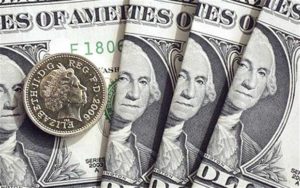 Yesterday’s trade saw GBP/USD within the range of 1.4971-1.4810. The pair closed at 1.4935, gaining 0.63% on a daily basis, a fourth straight daily increase.
Yesterday’s trade saw GBP/USD within the range of 1.4971-1.4810. The pair closed at 1.4935, gaining 0.63% on a daily basis, a fourth straight daily increase.
At 7:43 GMT today GBP/USD was up 0.25% for the day at 1.4972. The pair held in a daily range of 1.4916 – 1.4982.
Fundamentals
United Kingdom
The Claimant Count Change, which represents the change in the number of unemployed people in the UK during the respective month, probably registered a drop of 29 500 in March, following a 31 000 decline in February. A revised 39 400 drop was seen in January. The Office for National Statistics will release the report at 08:30 GMT.
Meanwhile, unemployment rate in the UK probably slid to 5.6% in the three months through February, the ONS is expected to report. The metric gauges the number of jobless people actively seeking employment as a percentage of the labor force.
Jobless rates were steady at 5.7%, the lowest since mid-2008, in the three months ended January 2015. There were 1.86 million unemployed people, 102 000 less than the August-October 2014 period and 479 000 fewer than a year earlier.
The ONS is also expected to report that wage growth saw a continued growth in February, with the Average Earnings Index including Bonus projected to have risen by 1.8%, following another 1.8% jump the previous month. If confirmed, this would be the eight straight month of pay growth. Average Earnings excluding Bonus likely rose by 1.7% in February, according to analysts estimates.
United States
Annualized consumer inflation in the United States was probably at 0.1% in March, according to market expectations, following a flat reading in February as a decline in the energy index was offset by a higher cost of food, shelter and medical care. Januarys reading registered a 0.1% deflation which was the lowest rate since October 2009, when an inflation of -0.2% was reported. In monthly terms, the Consumer Price Index (CPI) probably rose 0.3%, after jumping 0.2% in February which ended a string of three consecutive months of declines.
The CPI is based on a basket of goods and services bought and used by consumers on a daily basis. In the United States the Bureau of Labor Statistics (BLS) surveys the prices of 80 000 consumer items in order to calculate the index. The latter reflects prices of commonly purchased items by primarily urban households, which represent about 87% of the US population. The Bureau processes price data from 23 000 retail and service businesses.
The CPI includes sales taxes, but excludes income taxes, costs of investments such as stocks and bonds and sales prices of homes.
The annualized core consumer inflation, which is stripped of prices of food and energy, probably remained flat at 1.7% in March. The metric was at 1.6% in December and January which was the lowest annual core inflation since February 2014. It is usually reported as a seasonally adjusted figure, because consumer patterns are widely fluctuating in dependence on the time of the year.
Core CPI is the gauge which the Federal Reserve Bank takes into account in order to adjust its monetary policy because prices of food, oil and gas are highly volatile, while the central bank’s tools are slow-acting. In case, for example, prices of gas surge considerably, this could lead to a high rate of inflation, but the central bank will not take action until this increase affects prices of other goods and services.
If the CPI tends to distance itself from the inflation objective set by the Federal Reserve and considered as providing price stability, this usually reduces the appeal of the US dollar. However, quite high rates of inflation (well above the central bank’s inflation target) can be harmful to the economy, and as a result, this may lead to the loss of confidence in the local currency.
The Bureau of Labor Statistics is to release the official CPI report at 12:30 GMT.
Michigan confidence
A separate preliminary report by the Thomson Reuters and the University of Michigan may show that consumer confidence in the United States improved in April from a month earlier. The preliminary reading of the corresponding index, which usually comes out two weeks ahead of the final data, is expected at 94.0 from Marchs final reading of 93.0. The gauge was at 95.4 in February.
The survey encompasses about 500 respondents throughout the country. The index is comprised of two major components, a gauge of current conditions and a gauge of expectations. The current conditions index is based on the answers to two standard questions, while the index of expectations is based on three standard questions. All five questions have an equal weight in determining the value of the overall index.
The sub-index of current economic conditions likely rose to 105.2 in April from a final reading of 105.0 in March, while the sub-index of consumer expectations is projected at 87.0 from 85.3 last month.
In case the gauge of consumer sentiment came in above projections, this would boost demand for the greenback. The preliminary reading is due out at 14:00 GMT.
Pivot points
According to Binary Tribune’s daily analysis, the pair’s central pivot point stands at 1.4905. In case it penetrates the first resistance level at 1.5001, it will encounter next resistance at 1.5066. If breached, upside movement may attempt to advance to 1.5162.
If the cross drops below its S1 level at 1.4840, it will next see support at 1.4744. If the second key support zone is breached, downward movement may extend to 1.4679.
In weekly terms, the central pivot point is at 1.4733. The three key resistance levels are as follows: R1 – 1.4881, R2 – 1.5131, R3 – 1.5279. The three key support levels are: S1 – 1.4483, S2 – 1.4335, S3 – 1.4085.





